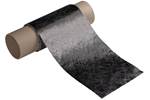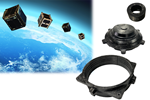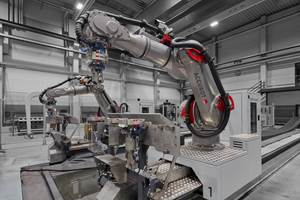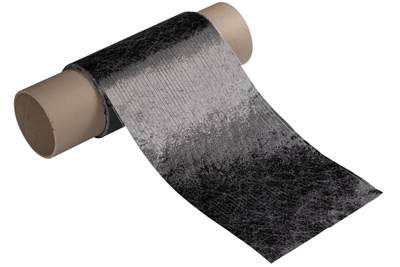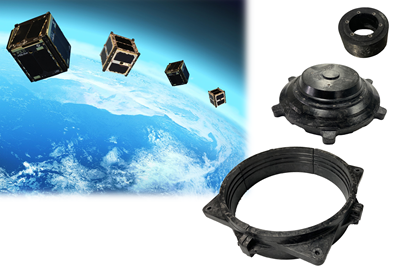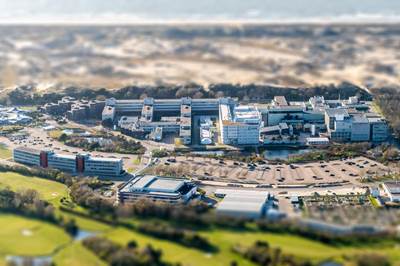Share
A constellation of satellites is prepped for deployment, housed within a rocket's payload bay. These satellites are equipped with rapidly manufactured composite deployable solar arrays. Source | Kerberos Engineering
In recent years, there has been a notable increase in the global demand for composites tailored for space applications, driven by the emergence of private space firms and satellite manufacturing in the race to increase accessibility to space. This trend has spurred heightened interest among satellite producers in procuring high-performance composite satellite components that can be tailored to specific mission requirements and manufactured with accelerated timelines. As a result, these manufacturers are reevaluating their production methodologies and technologies to align with this demand.
Kerberos Engineering (Murcia, Spain) holds a prominent position in the development of space-grade composite satellite subsystem structures. The company’s expertise lies in deployable satellite solar array structures, for which it has integrated 0/90 woven spread tow fabrics provided by TeXtreme (Borås, Sweden) in the production of these carbon fiber-reinforced polymer (CFRP) components. The strategic selection of materials has led to a 90% reduction in resources required for manufacturing the solar array compared to conventional techniques. This optimization has led to improved technology access, enhanced satellite onboard resource efficiency and a substantial contribution to industry performance and sustainability.
Designing deployable solar arrays
“The primary system design requirements for a deployable solar array are light weight and high stiffness characteristics to minimize costs in the launch phase and reduce angular momentum during the satellite’s positioning maneuvers to orient to ground links and maintain its orbital trajectory,” Dr. Emilio Lozano, the founder and owner of Kerberos Engineering, explains. “This calls for the use of high-modulus primary materials that can be manufactured into thin components to meet these specific demands. In addition to this, the system design and material selection should be fine-tuned for space environment compatibility and efficient production to align with market demands.”
A rendering depicting the deployment of a solar array in orbit highlights the operational layout of an under-development solar array system. Source | Kerberos Engineering
“Through the use of TeXtreme 0/90 material and a specific infusion technique, we have achieved a 90% reduction in resources for space-grade satellite solar array production compared to other suppliers,” highlights Lozano. “The most notable benefit is the material’s significant reduction in labor requirements. Traditional unidirectional [UD] prepreg materials necessitate a labor-intensive, meticulous layer-by-layer application. Each layer must be precisely aligned and carefully handled to avoid fraying and separation, leading to extended production times and increased labor costs.
“In contrast, TeXtreme 0/90 simplifies this process with its woven structure and compatibility with our in-house developed variation of vacuum-assisted resin transfer molding [VARTM],” he continues. “The technique allows for the rapid and uniform infusion of resin, thereby reducing the overall labor input and expediting production by up to 90%. The cost efficiency achieved with TeXtreme 0/90 is also remarkable. With TeXtreme 0/90, the streamlined VARTM process minimizes handling complexity and reduces the need for multiple curing stages. The uniform resin distribution and controlled curing environment further cut down on labor and energy expenses, making the production process more competitive.
“Material efficiency is another critical benefit of TeXtreme 0/90 over traditional UD prepregs,” Lozano adds. “The woven fabric minimizes issues such as fraying and fiber separation, common in UD prepregs, leading to material waste. The 0/90 configuration of TeXtreme ensures structural integrity and reduces the need for excessive layering to achieve desired properties. This results in a lightweight, high-strength composite essential for satellite applications. By utilizing fewer layers and optimizing material use, TeXtreme 0/90 not only meets the stringent performance requirements of space environments but also significantly reduces material waste, further lowering production costs and environmental impact.”
Optimized woven fabric, in-house VARTM
Kerberos Engineering’s solar arrays, designed to be tailorable for specific applications, measure approximately 500 × 700 millimeters, and consist of up to seven panels. Construction of these panels is optimized per application requirements — e.g., sandwich-structured face sheets consist of three plies, while monolithic structures comprise seven plies of TeXtreme woven fabric.
The 0/90 material comprises 20-millimeter-wide UD spread tow fabric tapes with perpendicular warp and weft. The dry fabric weighs 42 gsm and features 0.3-millimeter gaps between fiber tows, tailored for resin infusion processes.
“Unique to TeXtreme’s 0/90 woven structure is its ability to balance each layer due to interlacing, allowing the three-layer sections to achieve the required performance in just 130 gsm, resulting in an all-balanced lightweight laminate,” highlights Lozano. “This is in contrast to typical prepreg laminates, which would likely exceed 500 gsm to achieve the same outcome.”
The CFRP deployable solar array sandwich panel cured and prepared for the fitting of photovoltaic cells. Source | Kerberos Engineering
During the production process, technicians lay the plies onto a mold, then debulk them under a vacuum bag to create the preform, which is subsequently transferred to VARTM. To ensure thorough wetting of the dry TeXtreme 0/90, a low-viscosity resin from Huntsman (The Woodlands, Texas, U.S.) is used, fostering structural integrity and high-rate production. Processing under vacuum, heat and pressure results in uniform resin distribution, creating a thin yet stiff panel structure.
“The thin yet strong structure allows for building laminates with various fiber angles without increasing thickness significantly,” explains Lozano, “while the perpendicular and interlaced configuration provides dimensional stability, minimizing warping during part processing. Moreover, the spread tow fiber architecture results in a high fiber volume fraction [FVF] exceeding 60%, aligning mechanical properties with UD prepreg solutions. The spread tows’ high permeability enables rapid and thorough wet-out across large surface areas, ideal for our agile production needs. The intentionally designed gaps function as effective channels for proper resin saturation, expediting consistent wetting with maintained mechanical properties.”
Controlled curing takes place during VARTM, where the material’s temperature is gradually increased up to 150°C and sustained for 6 hours to ensure optimal material characteristics. Post-processing includes machining and integrating inserts to prepare the panels for their final application. The solar panels are designed with an exposed side and a coated side to insulate the solar cells from their substrates. A silicon-based adhesive is used to bond the solar cells to the solar array panels, providing a secure and reliable attachment that contends with the significant temperature fluctuations when transitioning between sun-facing and space-facing positions.
After the consolidation process is finished, post-processing involves precision machining and integrating inserts to attach the hinge sections on each panel. Source | Kerberos Engineering
Developing TeXtreme 0/90
TeXtreme 0/90 is a 20-millimeter-wide unidirectional (UD) spread tow fabric with perpendicular alignment of warp and weft tapes. The dry fabric has a weight of 42 gsm and incorporates 0.3-millimeter gaps between fiber tows, specifically designed for resin infusion processes. Source | TeXtreme
According to Andreas Martsman, co-founder and VP of marketing and sales at TeXtreme, production of TeXtreme 0/90 entails a sophisticated combination of mechanical and chemical procedures. Martsman emphasizes that the proprietary domain lies in the weaving of spread tow fibers into extremely low area weights: “The advanced weaving looms, tailored to the properties of spread tow tapes, ensure accurate alignment and minimal distortion to preserve the performance of high-modulus fibers without compromising their integrity when it’s woven into a fabric.”
The use of spread tow tapes not only reduces fabric weight, Martsman notes, but fiber undulation as well, when compared to using narrower, thicker yarns. This minimizes fiber crimping and enhances mechanical performance by achieving a high FVF and straight load paths. Moreover, this material has been optimized to maintain flatness and prevent edges from folding. Martsman explains, “The focus has been on continuously fine-tuning and refining every aspect of the process to enhance output and quality, enabling the weaving of the most extreme tapes.”
Resisting outgassing, extreme temperatures and microcracking
To ensure the success of carbon fiber structures in space, it is essential to use high-modulus fibers in order to form structures that possess high specific strength, glass transition temperature (Tg), thermal stability and low water absorption.
“In the vacuum of space, molecular degradation can occur, leading to a phenomenon known as outgassing, which involves the release of trapped gas or vapor molecules such as sublimation, evaporation and desorption," explains Martsman. “Outgassing can result in mass loss and even cracking, which can compromise the performance of materials and mission success. Thus, composites used in spacecraft are made from materials with extremely low vapor pressure to minimize the risk of outgassing-related mass loss.”

The photovoltaic cells are integrated into the CFRP deployable solar array which are designed to be folded to the side of the satellite main body. At this stage, the satellite is affixed to its section of the payload pod body in preparation for launch. Source | Kerberos Engineering
The European standard for outgassing is a critical consideration for spacecraft due to its impact on safety and environmental factors. Outgassing can lead to material degradation, the generation of space debris and the contamination of the payload, posing risks to mission success and neighboring satellites. Compliance with these standards is indispensable for any company involved in space missions. The outgassing behavior of a material depends on the specific type of resin being used. To validate the construction of products, TeXtreme validates its materials through outgassing tests, placing the consolidated material in a vacuum chamber for an extended period of time and temperature cycling it to observe any potential failure.
“Kerberos Engineering has thoroughly tested the consolidated TeXtreme 0/90-based solar arrays to ensure their ability to withstand the launch and operational environment,” notes Lozano. “The thermal environment poses a significant challenge for solar arrays in space, as they experience rapid and high-temperature fluctuations when moving between direct exposure to the sun and the coldness of space. Therefore, the materials used must have a suitable Tg to withstand these conditions and prevent cracking.”
Martsman adds, “The TeXtreme plies play a crucial role in elevating the threshold at which microcracks develop. When the ultra-thin layers are stacked, they behave together, reducing the risk of fiber separation, initiation and propagation of microcracks, which allow for the structure to maintain structural integrity longer compared to conventional, thick plies. This enables the composite structure to bear loads close to the performance of the fibers, leading to the initial failure mode being fiber breakage rather than microcracking and delamination.”
Thin material precision, proven performance in space
Lozano emphasizes the ultra-thin nature of the TeXtreme 0/90 fabric, which provides greater precision in composite layups: “Ultimately, improving the robustness of lightweight satellite components in space is the goal, and the space-qualified TeXtreme 0/90 material gives reassurance for product reliability throughout the mission lifespan as it has been proven within this environment for several customers in the past.”
One notable example is NASA’s Ingenuity Mars helicopter, an unmanned aerial vehicle part of the Mars 2020 mission, deployed in 2021. TeXtreme’s material was used to fabricate its solar panel substrate, rotor blades and base structure. “The primary challenge for the development team was to find a fabric that could provide the necessary stiffness for lift while remaining lightweight to conserve energy,” says Lozano. “After an extensive search, they identified TeXtreme as a thin, stiff and ultra-light solution and worked with the engineering team to optimize a version for their specific requirements. The team was able to design the wings in an optimal way, enabling the helicopter to successfully navigate the harsh conditions of Mars. Thanks to this experience, we knew we could use the same technology.”
TeXtreme 0/90 has also been used in the composite deployable solar array structures for 30 satellites, which have demonstrated performance aligned with each satellite’s anticipated 5-year service life in orbit. Kerberos Engineering expects to integrate this technology into 15 more satellites, scheduled for launch in 2024. “This anticipated 50% expansion of our customer fleet over the next year is primarily attributed to technological advancements in our manufacturing processes,” says Lozano. “This growth validates not only our manufacturing advancements but also our material's ability to improve performance for satellite and space vehicle manufacturers.”
Related Content
ASCEND program update: Designing next-gen, high-rate auto and aerospace composites
GKN Aerospace, McLaren Automotive and U.K.-based partners share goals and progress aiming at high-rate, Industry 4.0-enabled, sustainable materials and processes.
Read MoreAutomated robotic NDT enhances capabilities for composites
Kineco Kaman Composites India uses a bespoke Fill Accubot ultrasonic testing system to boost inspection efficiency and productivity.
Read MoreCo-molding SMC with braided glass fiber demonstrates truck bed potential
Prepreg co-molding compound by IDI Composites International and A&P Technology enables new geometries and levels of strength and resiliency for automotive, mobility.
Read MoreBio-based acrylonitrile for carbon fiber manufacture
The quest for a sustainable source of acrylonitrile for carbon fiber manufacture has made the leap from the lab to the market.
Read MoreRead Next
Engine vane demonstrates potential for gapped, unidirectional dry fiber for infusion
GKN Aerospace and its partners developed an aircraft demonstrator component made with TeXtreme’s latest Gapped UD material, proving out a dry, infusible tape meant to compare in performance to UD prepreg.
Read MoreComposite molding compound replaces Invar for lightweight small satellite structures
Patz Materials and Technologies and Lawrence Livermore National Laboratory developed a new monolithic optics housing with 80% less weight, near-zero CTE and the high-volume manufacturing required for commercial space.
Read MoreHigh glass transition temperature, 100% bio-based thermoset resins for space composites
With the European Commission Restrictions Roadmap soon banning entire classes of chemical substances found in fossil fuel-based synthetic polymers, the space industry is looking to a chemical combination to produce competitive thermoset resins.
Read More


